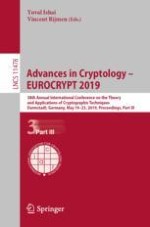2019 | OriginalPaper | Buchkapitel
From Collisions to Chosen-Prefix Collisions Application to Full SHA-1
verfasst von : Gaëtan Leurent, Thomas Peyrin
Erschienen in: Advances in Cryptology – EUROCRYPT 2019
Aktivieren Sie unsere intelligente Suche, um passende Fachinhalte oder Patente zu finden.
Wählen Sie Textabschnitte aus um mit Künstlicher Intelligenz passenden Patente zu finden. powered by
Markieren Sie Textabschnitte, um KI-gestützt weitere passende Inhalte zu finden. powered by
Abstract
MD5 and SHA-1, and obtain improved attacks. In particular, we have a chosen-prefix collision attack against SHA-1 with complexity between \(2^{66.9}\) and \(2^{69.4}\) (depending on assumptions about the cost of finding near-collision blocks), while the best-known attack has complexity \(2^{77.1}\). This is within a small factor of the complexity of the classical collision attack on SHA-1 (estimated as \(2^{64.7}\)). This represents yet another warning that industries and users have to move away from using SHA-1 as soon as possible.